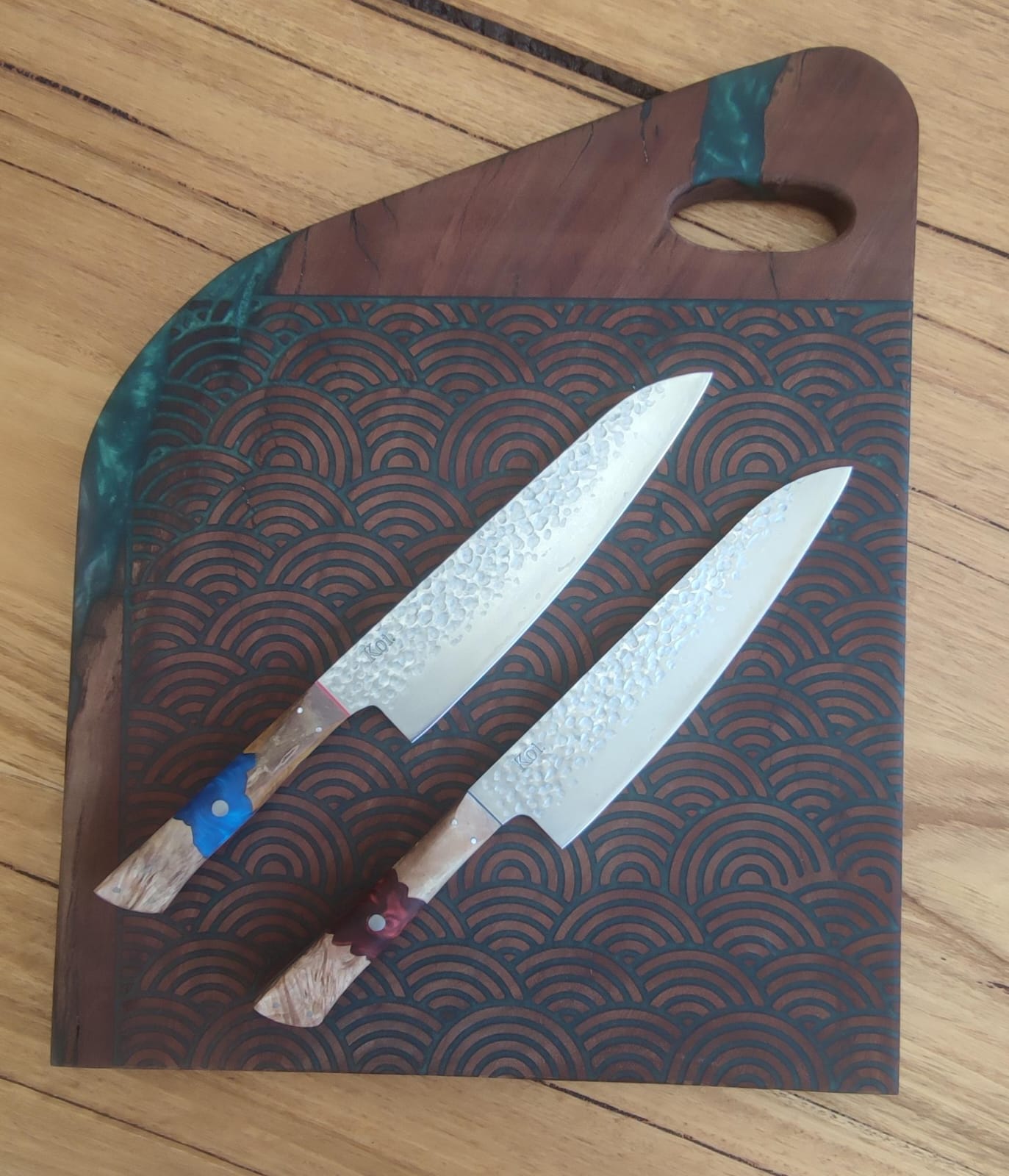Japanese knives have etched a fascinating journey through culinary history, tracing their origins deep inside Japan's rich culture. With centuries of workmanship and history behind them, these knives have crossed borders and left an indelible stamp on kitchens worldwide.
In this article, we delve into the captivating journey of Japanese knives, revealing their historical relevance and tremendous impact on global cuisine.
Beyond their borders, Japanese knives have established a prominent presence in kitchens worldwide, significantly influencing the methodologies employed by chefs in their culinary endeavours.
Evolution of Japanese Knives
Traditional Japanese Knife Craftsmanship
The art of Japanese knife crafting has a long-standing history that spans several centuries. Bladesmiths, who frequently adhere to longstanding family customs, precisely produce knives through manual craftsmanship. Time-honoured procedures, such as the "honyaki" method, were employed, involving the heating, quenching, and tempering a single piece of high-carbon steel. The outcome was blades that exhibited exceptional levels of sharpness and durability.
Modern Innovations in Japanese Knife Making
During the 20th century, the art of Japanese knife-making had significant advancements and innovations. Bladesmiths began integrating Western-style characteristics, such as double-bevelled edges, in response to the increasing worldwide market needs.
The introduction of high-quality stainless steel and alloys such as VG-10 and SG2 provided a desirable combination of sharpness and resistance to rust.
Global Recognition of Japanese Knife Quality
Japanese knives gained global acclaim for their exceptional quality. Chefs worldwide recognise their superior sharpness, precision, and longevity. Michelin-starred restaurants often rely on Japanese knives for their cutting-edge performance. These blades have transcended cultural barriers, becoming indispensable in global kitchens.
The Impact on Professional Kitchens
Japanese knives have made a profound impact on professional kitchens across the globe, revolutionising the way chefs approach their craft.
Adoption by Michelin-Starred Restaurants
In the competitive world of fine dining, every detail matters. Michelin-starred restaurants are known for their uncompromising pursuit of perfection, and this pursuit extends to the tools they use. Japanese knives have found a special place in the kitchens of these prestigious establishments.
The reasons are clear: their exceptional sharpness, precision, and balance align perfectly with the demands of haute cuisine.
The Preference of World-Renowned Chefs
Renowned chefs, celebrated for their culinary innovations, are often selective about the tools they employ. Many have embraced Japanese knives as their cutlery of choice.
The blades' superior craftsmanship and attention to detail appeal to their discerning tastes. These chefs recognise that the right knife extends their creativity and skill.
Efficiency and Precision in Modern Cooking
In today's fast-paced culinary world, efficiency is paramount. With razor-sharp edges and lightweight designs, Japanese knives allow chefs to work swiftly and accurately. They offer unparalleled control, Whether thinly slicing sashimi or precisely dicing vegetables. This efficiency improves cooking speed and elevates the overall quality of dishes.
Japanese Knives in Different Culinary Traditions
Japanese knives have made a significant impact on various culinary traditions around the world, contributing to the evolution of these cuisines.
Sushi and Sashimi Preparation
One of the most iconic uses of Japanese knives is in preparing sushi and sashimi. The precision and sharpness of Japanese blades are essential for creating delicate, paper-thin slices of raw fish. Sushi chefs rely on the finesse of Japanese knives to ensure their dishes' perfect texture and presentation. These knives have become synonymous with the artistry of sushi-making, elevating it to new heights globally.
Fusion Cuisine and the Adaptability of Japanese Knives
Japanese knives have found a special place in fusion cuisine, where culinary traditions from different cultures meld into innovative dishes.
Their adaptability and versatility make them indispensable tools for chefs who create fusion masterpieces. Whether it's combining Japanese techniques with French cuisine or infusing South Asian flavours into Japanese dishes, these knives excel in precision, allowing chefs to experiment with confidence.
Impact on Western and Other Culinary Styles
The influence of Japanese knives is not limited to Asian cuisines. In Western kitchens, chefs have recognised the superiority of Japanese blades for tasks that demand precision and finesse. From julienning vegetables to carving roasts, Japanese knives have infiltrated traditional Western culinary practices, enhancing efficiency and quality.
The Pursuit of Perfection: Why Japanese Knives Are Coveted
Japanese knives have earned their revered status due to several distinct characteristics that set them apart in the culinary world:
Blade Materials and Sharpness
- High Carbon Steel: Japanese knives are often forged from high-carbon steel, known for their exceptional hardness and ability to maintain a razor-sharp edge.
- Advanced Heat Treatment: Meticulous heat treatment processes ensure that these blades achieve unparalleled hardness, resulting in remarkable edge retention.
- Precision Honing: Japanese blades are sharpened to extreme levels of sharpness, allowing chefs to make precise cuts with minimal effort.
-
Unique Designs and Craftsmanship
- Tapered Blades: Japanese knife blades typically feature thin, tapered profiles that enhance precision during slicing, chopping, and dicing.
- Intricate Patterns: Many Japanese knives boast intricate Damascus or herringbone patterns, showcasing the craftsmanship of skilled artisans.
- Wooden Handles: Traditional wooden handles, often made from Japanese hardwoods like wood or magnolia, offer a comfortable and natural grip.
-
Balance, Weight, and Ergonomics
- Perfect Balance: Japanese knives are expertly balanced, ensuring that they feel like an extension of the chef's hand.
- Lightweight: The lightweight nature of Japanese knives minimises fatigue during extended kitchen sessions, contributing to precise cuts.
- Ergonomic Handles: Handles are thoughtfully designed for comfort and reduced strain, allowing chefs to work comfortably for hours.
The Future of Japanese Knives
Innovations in Knife Design and Materials
Japanese knife makers continue to push the limits of design and materials. Innovations like layered Damascus steel for unrivalled strength and precision and ergonomic handles for enhanced grip and control are becoming commonplace. These knives are not just tools but works of art, blending cutting-edge technology with centuries-old craftsmanship.
Global Availability and Affordability
As demand for Japanese knives grows, their availability worldwide is rising. Thanks to online shops and specialised retail establishments, these blades are now easier to obtain.
Furthermore, rising competition has reduced the price of many Japanese knife options, bringing their high quality into reach of chefs and enthusiasts worldwide.
The Continued Evolution of Japanese Knife Culture
Japanese knife culture is a living, breathing force in the culinary world. Precision, craftsmanship, and respect for the ingredients are principles that continue to influence chefs around the world. Japanese knife producers work with chefs to develop specialised instruments for emerging culinary trends, ensuring that the Japanese knife heritage adapts to meet the ever-changing demands of the kitchen.
Conclusion
Japanese knives have orchestrated a remarkable transformation in global cuisine. Their outstanding craftsmanship and unrivalled sharpness have earned them a prestigious place in professional kitchens worldwide. These knives are both a culinary tool and an expression of Japanese culture and artistry.
Recognising their cultural and culinary value celebrates precision and dedication, not just a nod to tradition. Japanese knives will continue to impact culinary landscapes in the future, their legacy ringing in every precisely cut ingredient and every amazing dish they assist in producing.




